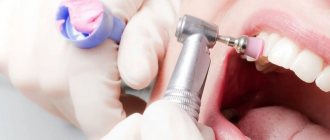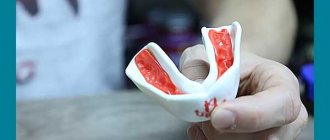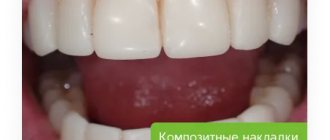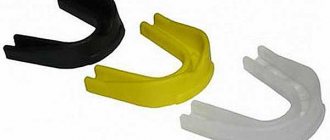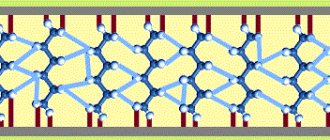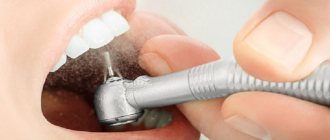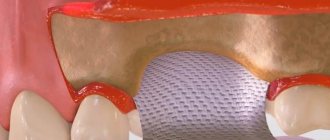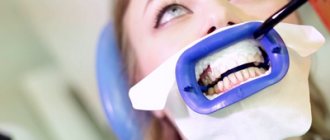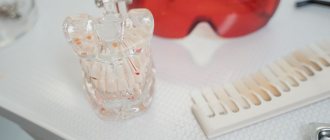The external attractiveness of the dentition is an important factor that provides psychological confidence to the patient. Unfortunately, standard hygiene procedures, even when carried out regularly, do not guarantee the preservation of enamel in proper condition. Professional grinding allows you to restore the natural shade of teeth, as well as remove plaque accumulations that form in hard-to-reach areas. The cost of ultrasonic teeth cleaning at the dentist is fully compensated by the results achieved, so for those who prefer to take care of their own health, it is recommended to pay attention to the proposed option.
Why do you need teeth polishing?
Many patients in dental clinics do not take the procedure seriously and ask the doctor the question of why teeth polishing is needed. Eliminating uneven surfaces of teeth not only makes teeth smooth and gives them a healthy shine. The procedure is carried out to achieve the following goals:
- prevention and removal of soft deposits and tartar;
- smoothing of enamel before starting orthodontic treatment;
- adjustment of the cutter shape;
- removing pigmentation from enamel, evening out its color;
- selection of the material of the desired color before filling.
Thus, both to restore the beauty and health of a smile, polishing and grinding of teeth are periodically carried out - the differences are that the first manipulation involves mechanical leveling of the surface. And the second is to give perfect smoothness. The need for procedures is determined by the dentist.
Features, recommendations and contraindications
Grinding is one of the stages included in a comprehensive teeth cleaning program. The procedure is an intermediate link between removing stone deposits and polishing the enamel. It is important to take into account that the active impact on the dentition carried out during the grinding process is a stress factor, the negative consequences of which can be neutralized by special compositions that help strengthen the enamel layer.
The purpose of the procedure is determined by the presence of the following factors identified during the preliminary examination:
- The need to remove fossilized plaque, which worsens the shade of the enamel and contributes to the development of pathological processes, which result in the occurrence of caries and diseases of the gum tissue;
- Discomfort experienced by the patient due to disruption of the natural smooth structure of the enamel coating associated with professional cleaning performed mechanically or ultrasonic;
- Preparation for orthodontic treatment, which involves the installation of permanent or removable corrective structures, including braces and mouth guards.
Grinding is also carried out when filling the dentition - the procedure for processing the restored surface allows you to achieve the desired shape of the crown, restore occlusion and remove excess material that has gone through the polymerization stage. It is important to take into account the features of the anatomical structure of teeth - both from the point of view of aesthetics and from the point of view of preventing possible diseases associated with the development of inflammatory processes, malocclusion and other factors that arise against the background of improper treatment of the unit.
The factors limiting the possibility of providing the service include the same phenomena as in the case of other dental procedures:
- Diagnosis of viral and infectious diseases;
- Identification of inflammatory foci affecting mucous tissues;
- Carious and other dental pathologies;
- Thinning of the enamel coating.
The decision on the need for dental polishing is based on the results of the clinical picture formed during the examination.
Contraindications to teeth polishing
The benefits of polishing for the health and aesthetics of a smile cannot be overestimated. However, at present there are several contraindications to its implementation:
- gum disease;
- caries;
- increased sensitivity of enamel;
- the occurrence of any inflammation in the oral cavity;
- individual intolerance to at least one of the components of the drug;
- adherence to a salt-free diet for renal failure;
- the presence of certain chronic diseases.
Therefore, before undergoing the procedure, it is necessary to consult a dentist.
Possible consequences
Despite the development of technology, polishing tooth enamel is still not the most pleasant procedure for which you should prepare in advance. To ensure the psychological and physical comfort of the patient, local anesthesia is used to eliminate pain.
It is also worth considering that after treatment, the sensitivity of the enamel increases, so the reaction to sudden temperature changes after the effect of painkillers wears off can be unpleasant. It is recommended to follow medical recommendations that prescribe a temporary exclusion of hot and iced foods and drinks from the diet, as well as a reduction in the amount of solid food, the consumption of which leads to an increase in mechanical stress on weakened enamel.
Polishing paste
Special polishing pastes contain abrasive particles, with the help of which a leveling effect is achieved. Depending on the size of the abrasive, cleaning compounds are divided into several categories:
- 250 – blue paste with large abrasive particles, used to remove residues of hard plaque and filling material;
- 170 – green composition with medium-sized polishing particles;
- 120 – red fine-grained paste to eliminate minor imperfections;
- 40 – yellow composition with microparticles for treating sensitive areas.
During dental procedures, the doctor first uses a paste with large abrasive particles. And then gradually moves on to treating the tooth surface with fine-grained compounds. During the procedure, pastes are applied to special tools for polishing teeth: drill attachments in the form of rubber cups, cone-shaped brushes, as well as strips (polishing strips).
Pastes for removing plaque and polishing tooth surfaces
Pastes for professional oral care are intended for removing non-mineralized dental plaque, immature tartar and pigmented plaque (high- and medium-abrasive pastes), as well as for polishing the tooth surface after removing dental plaque (low-abrasive polishing pastes). The composition of the pastes is close to that of toothpastes for individual use. Professional pastes may be distinguished by higher abrasiveness (usually they are divided by the size of the abrasive filler particles) and the absence of active components, with the exception of mineralizing ones. Pastes may or may not contain fluoride. Fluoride-free pastes can be used to clean teeth before sealing fissures or before filling cavities with composite materials. In these cases, the use of fluoride-containing pastes can disrupt the formation of the microporous structure of the enamel when it is etched with acid. Fluoride-containing polishing pastes usually contain from 1000 to 20,000 ppm of fluoride ions (as part of sodium fluoride, sodium monofluorophosphate or tin fluoride), but their caries-preventive effect has not been definitively proven. Pumice, silicate or zirconium oxide, silicon dioxide are used as abrasive fillers , calcium phosphates.
For ease of use, the paste is placed in a special cup, or a unidose of paste (Fig. 130) is fixed in a special ring on the finger (Fig. 131) or a holder (Fig. 132, A), which is held between the doctor’s fingers (Fig. 132, B) . Treatment with paste is carried out using an end brush, a soft rubber cap (cup), and flat dental floss.
Stages of the procedure
Treatment of the tooth surface takes place in several stages. Before polishing your teeth, the doctor selects the necessary attachment and abrasive composition. Next, the following manipulations are performed:
- Cleaning flat surfaces and dental cusps. At this stage, blue or green paste is used.
- Carry out polishing using a finely dispersed cleaning composition.
- Mouth rinse.
- Applying fluoride varnish to tooth enamel.
The total duration of the procedure does not exceed 40 minutes. In this case, the patient feels quite comfortable, there is no pain.
The same sequence of actions is maintained when selective tooth polishing is carried out: not everyone knows what it is and when it is necessary. However, the essence of the manipulation is the same, only the surface of the filling or dental crown is polished.
When is dental restoration necessary?
The most common reasons include:
- Chips and cracks in teeth.
- Incorrect position.
- Destruction of dental tissues.
- Irregular tooth shape or length.
- Change in enamel color.
- Replacing an old filling.
Modern dentistry and the latest technologies make it possible to correct a variety of defects. In addition, by carrying out the restoration procedure with the latest filling material, the tooth is restored to its original appearance and functionality. Today the following materials are used for dental restoration: photopolymers or glass ionomer cement. They can be adjusted to match the natural color of the teeth. Usually the filling looks very natural and does not stand out.
Recommendations after teeth polishing
After performing the above dental procedures, your smile will shine with health and whiteness. To maximize the positive effect, it is recommended to follow several rules:
- for the first 3-4 days, give up colored drinks, such as strong tea, coffee, bright juices;
- during hygiene procedures, do not use active whitening pastes so as not to damage the enamel;
- At first, stop smoking, since tobacco smoke actively destroys the protective layer of enamel and contributes to the accumulation of plaque.
Quite often, after receiving dental services, patients wonder how to restore tooth enamel after grinding and polishing. Because she becomes quite sensitive. The answer is simple - after polishing, dental clinics carry out fluoridation. And brushing your teeth with air flow before polishing will help achieve an even greater effect.
As you can see, polishing is a very useful procedure. If done regularly, your smile will always look great. And most dental diseases will remain a thing of the past forever.
And if you want a flawless smile without polishing, then composite veneers or porcelain veneers are the right option for you.
The doctor's consultation
Polishing the filling
Grinding and polishing the filling is the final stage of tooth restoration. The aesthetic appearance of the restoration depends on it. The final processing of composite filling material is carried out immediately after its application, but dentists recommend performing it the next day after the manipulations. You can grind both old and newly installed fillings. Modern dental clinics offer clients the opportunity to take advantage of new possibilities for finishing fillings. They use new materials that allow the procedure to be completed in just 10-15 minutes.
Why do you need to polish a filling?
Professional teeth cleaning in a dental office ensures the removal of deposits: plaque, stone, interdental dirt. But even after these procedures, the surface of the units may not be ideal. Microcracks, depressions, and grooves may be observed on them. These injuries are small, invisible, and do not pose a danger. However, after the first meal, deposits will begin to accumulate in them. So, cleaning essentially becomes useless.
Polishing the filling: before/after
A similar problem can occur after installing a new filling material that is not smooth. If it is not polished, it will cause discomfort and after a while secondary caries will begin to develop.
Indications and contraindications
The procedure for leveling and polishing tooth enamel is advisable in the following cases:
- Before preparing for oral surgery (as a preventive measure).
- Before prosthetics, to bring the color of the prosthesis as close as possible to the shade of the enamel of the “native” teeth.
- After removing braces, deposits and plaque actively accumulate around the locks, under which dental glue remains.
- After installing the filling for the purpose of adjustment - so that it does not interfere. Sometimes for polishing existing filling material.
Among the contraindications, it is worth noting periodontal disease, periodontitis, enamel hypersensitivity, the presence of wounds, inflammation, and damage in the oral cavity. Also caries. Allergy to medications used during the procedure.
Types of polishing and tools for its implementation
The main tools of a dentist are drill attachments and special pastes. The rotation of the nozzles is carried out at a speed of 2000 to 5000 rpm. In this case, the enamel does not heat up and damage.
Each type of nozzle has its own specific purpose. Rubber cups – for leveling flat surfaces of crowns. Cone-shaped - for eliminating growths, bumps and polishing the chewing area. Strips coated with diamond strips (crumbs) - for grinding interdental spaces.
Polishing a filling: tools
Pastes have different degrees of abrasion. To remove stone-like deposits and filling material, dentists use a blue paste with large particles. Green is aimed at combating small irregularities in the enamel. Red paste is used for final leveling. Yellow ones are suitable for people with sensitive enamel.
The most common polishing method is mechanical. But it does involve the use of attachments and pastes. Dentists also use a drill. But there are other types. They are used mainly by private dental clinics, while mechanical ones are mostly used by public ones.
Ultrasonic method. The filling is exposed to waves of different frequencies, which have a polishing effect. Sandblasting (involves the use of an apparatus that supplies air to the dental units) with a polishing effect. Laser polishing of enamel is also popular. This method guarantees a perfectly smooth surface and disinfection.
Preparation for polishing the filling and carrying out the procedure
To make it convenient for the dentist to work, an expander is placed in the patient’s mouth. It is important not to injure soft tissues with attachments; cotton swabs, which the dentist also places in the space between the gum and cheek, will help with this. To protect the eyes from small particles spreading, the patient wears special glasses. Next, the doctor determines how sensitive the elements of the dentition are, and then selects attachments and types of pastes. The paste is placed in a signet ring holder, then the machine gradually delivers it to the treatment area.
Tooth enamel polishing is performed sequentially:
- Flat surfaces.
- Chewing zone.
- Spaces between teeth.
The manipulations are repeated twice. First with coarse paste. The second treatment is with fine-grained paste.
Despite the absence of restrictions on the patient's contraindications, after polishing the enamel, he receives recommendations for quick rehabilitation. After the session, you may experience an unpleasant taste in your mouth. This phenomenon is temporary.
Important information. Many people are interested in whether the procedure is painful or not. Enamel polishing using any method is carried out without anesthesia. It is absolutely painless and lasts a maximum of half an hour. During the session, an extra-soft abrasive with silica and rubber cups and cone-shaped brushes is used. Dentists recommend smoothing the surface of teeth every six months.
How to care for polished teeth
First of all, it is advisable not to eat food containing dyes for three days after polishing the enamel. You need to not eat or drink anything hot or cold for several days. Buy a toothbrush with soft bristles, especially if you have hypersensitive teeth. It is not recommended to use toothpaste with a whitening effect as it contains abrasive particles. The enamel, therefore, will undergo their influence; you should not damage it again, otherwise it will completely darken. You need to avoid smoking for at least a week.
Expert advice. If you smoke, but want your enamel to not turn yellow or darken after polishing and/or whitening, get rid of the bad habit. Coffee and tea practically do not change its color, but nicotine does. No matter how much you polish and whiten your fillings and teeth, if you smoke, at least once a year, in this case you will have to visit the dentist’s office to remove the yellowness.
If you want your tooth enamel to be smooth, polished, without depressions and cracks in which deposits accumulate, make an initial appointment with your dentist. Take care of your teeth, get examined by a dentist once a year, and your teeth will be healthy and your smile will be “Hollywood.” To get started, you can get a consultation by phone.
What types of materials are there for dental restoration?
| Filling material Filtek (USA) | Universal nanocomposite for restoration of anterior and chewing teeth. The most important thing when restoring the front teeth is to choose the right color so that the restored tooth does not differ from the rest. To restore chewing teeth – strength and stability. This material is made not only for fillings, but also for onlays and splinting. |
| Light-curing composite Venus (Germany) | A new filling material, which consists of the smallest nanoparticles, allowing to achieve a high aesthetic effect. Venus composites can be used to recreate the natural shine and color of teeth. This composite is also characterized by high durability and strength, which allows it to be often used when restoring chewing teeth. |
| Photocomposite Enamel Plus (Italy) | When using it, you can achieve the desired tooth shape and achieve 100% natural color thanks to a huge palette of shades. This composite is sometimes called a “chameleon” because over time it is able to adapt to the natural color of the tooth. |
